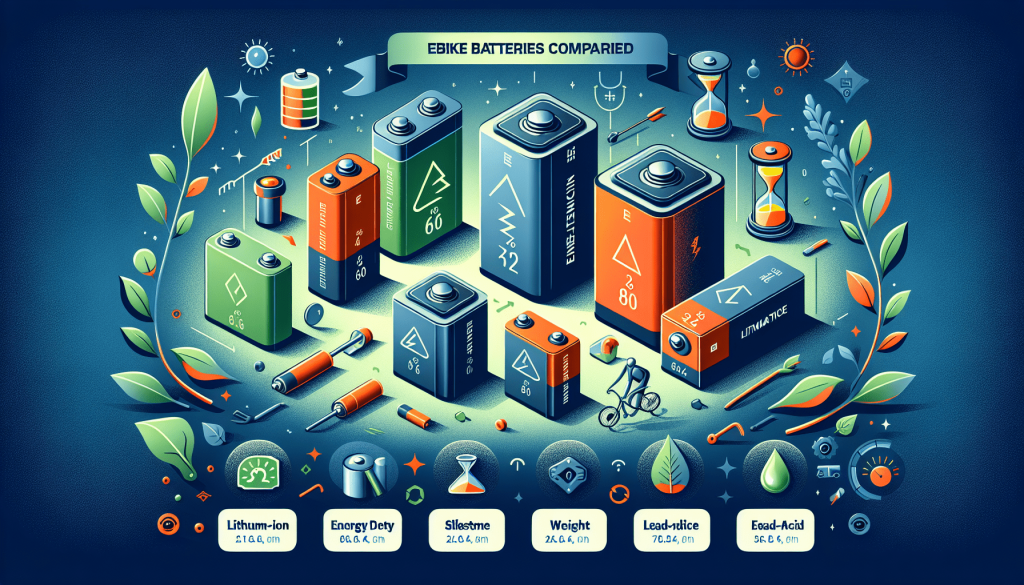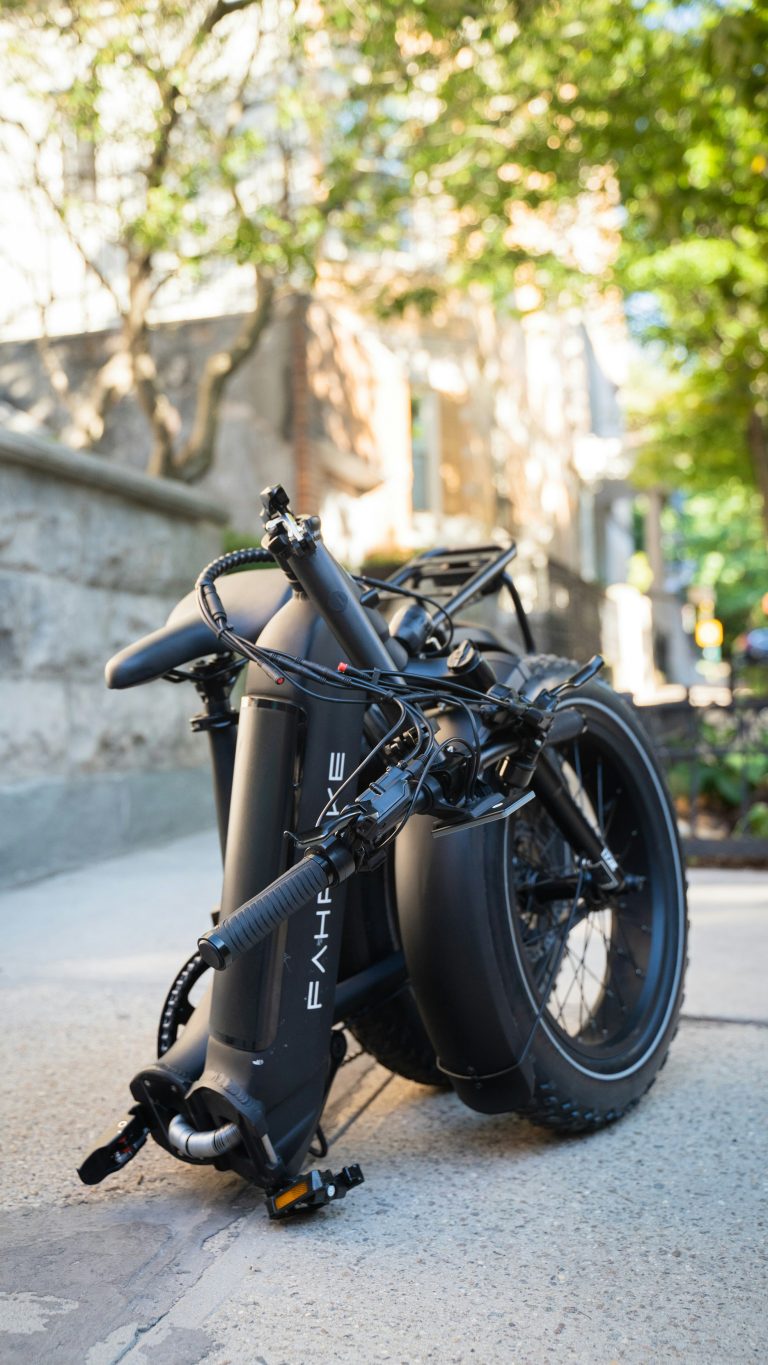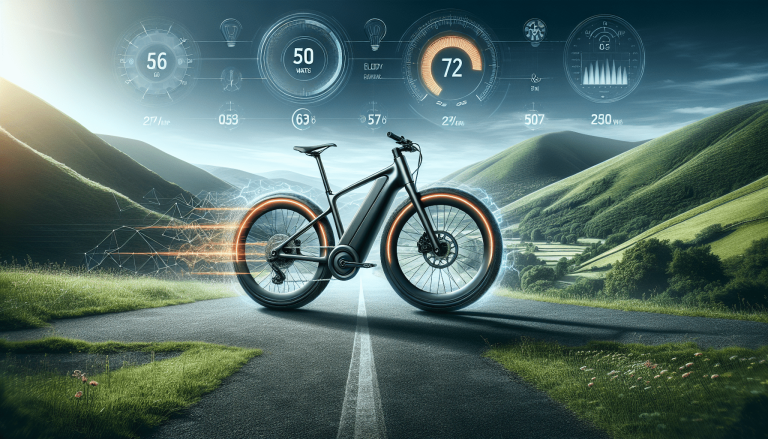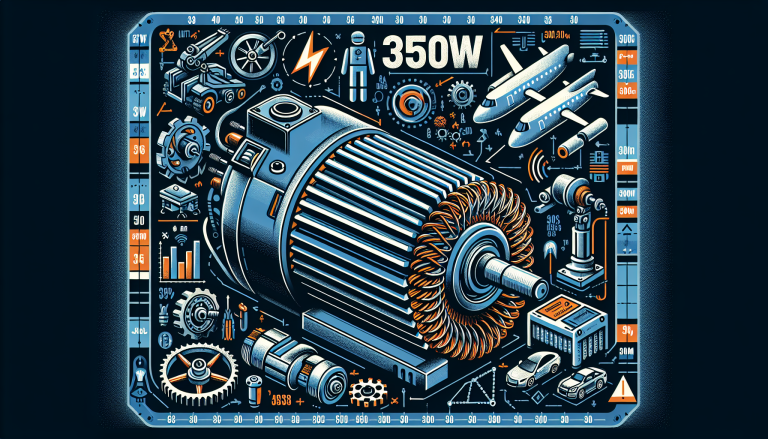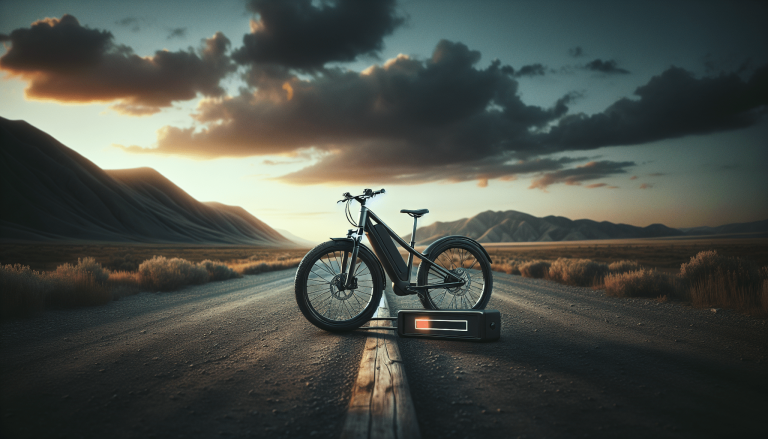Which Battery Cell Is Best For EBike?
Are you in the market for an eBike and wondering which battery cell to choose? Look no further! In this article, we will explore the different options available and help you determine which battery cell is best suited for your eBike needs. From long-lasting lithium-ion batteries to powerful nickel-metal hydride cells, we will provide you with a comprehensive overview of the pros and cons of each, ensuring that you make an informed decision for your next eBike adventure. So, let’s dive in and discover the perfect battery cell for your eBike!

Lithium Ion Batteries
High energy density
Lithium-ion batteries are known for their high energy density. This means that they can store a large amount of energy in a compact size, making them an excellent choice for eBikes. With a high energy density, you can expect a longer range and more power from your eBike.
Long lifespan
Another advantage of lithium-ion batteries is their long lifespan. These batteries can typically last for several years with proper care and maintenance. This means that you won’t have to worry about constantly replacing your eBike battery, saving you time and money in the long run.
Lightweight and compact
Lithium-ion batteries are both lightweight and compact, making them ideal for eBikes. Their smaller size and lower weight contribute to the overall agility and maneuverability of the eBike. This makes it easier to handle and ride, especially when compared to heavier lead acid batteries.
Fast charging capabilities
One of the most sought-after features of lithium-ion batteries is their fast charging capabilities. With a lithium-ion battery, you can recharge your eBike quickly and get back on the road in no time. This is especially convenient for riders who rely on their eBikes for their daily commute or regular transportation.
Expensive upfront cost
While lithium-ion batteries offer many benefits, they do come with a higher upfront cost compared to other battery types. However, it’s important to consider the long-term value and benefits that lithium-ion batteries provide. Ultimately, the higher cost can be justified by their high energy density, long lifespan, and fast charging capabilities.
Lead Acid Batteries
Relatively low cost
Lead acid batteries are known for their relatively low cost compared to other battery types. This makes them an attractive option for riders who are on a budget or looking for a more affordable eBike battery solution.
Heavy and bulky
One of the downsides of lead acid batteries is their weight and bulkiness. These batteries tend to be heavier and larger in size compared to lithium-ion and other battery types. This can affect the overall agility and handling of the eBike, making it less maneuverable.
Limited lifespan
Lead acid batteries have a relatively limited lifespan compared to lithium-ion and other battery types. They may need to be replaced more frequently, which can add to the overall cost and maintenance of the eBike.
Slow charging
Another drawback of lead acid batteries is their slow charging time. Charging a lead acid battery can take longer compared to lithium-ion batteries, which can be inconvenient for riders who need their eBikes ready to go quickly.
Not suitable for high-performance eBikes
Lead acid batteries are not typically suitable for high-performance eBikes. They may not provide the power and range needed for riders who want to push the limits and experience faster speeds or tackle challenging terrains.
Nickel-based Batteries
Nickel-cadmium (Ni-Cd) batteries
Nickel-cadmium batteries are a type of nickel-based battery. They offer a moderate energy density, making them suitable for eBikes that require a balance between power and weight.
Nickel-metal hydride (NiMH) batteries
Nickel-metal hydride batteries, another type of nickel-based battery, offer a higher energy density compared to nickel-cadmium batteries. This means that they can store more energy in a smaller size, providing increased power and range.
Moderate lifespan
Both nickel-cadmium and nickel-metal hydride batteries have a moderate lifespan. With proper care and maintenance, they can last for a reasonable amount of time before needing replacement.
Better performance in extreme temperatures
One of the advantages of nickel-based batteries is their better performance in extreme temperatures. They are more resistant to temperature fluctuations, making them suitable for riders who may encounter hot or cold weather conditions.
Ni-Cd batteries have memory effect
It’s important to note that nickel-cadmium batteries have a memory effect. This means that if they are not fully discharged before being recharged, their overall capacity may be reduced over time. Proper charging and discharging strategies can help mitigate this issue.
NiMH batteries have higher energy density and no memory effect
Nickel-metal hydride batteries offer a higher energy density compared to nickel-cadmium batteries, and they do not suffer from memory effect. This makes them a more desirable choice for eBikes that require a higher power output and longer range without the need for special charging practices.
NiMH batteries are less toxic than Ni-Cd batteries
Another advantage of nickel-metal hydride batteries is that they are less toxic compared to nickel-cadmium batteries. This makes them a more environmentally-friendly option for riders who are conscious of their ecological impact.
Lithium Polymer Batteries
Similar technology to lithium-ion
lithium polymer batteries (LiPo) use a similar technology to lithium-ion batteries. They both rely on lithium-ion cells to store and release energy. LiPo batteries, however, have a different form factor and design that allows for more flexibility and versatility.
Flexible and versatile form factor
One of the main advantages of lithium polymer batteries is their flexible and versatile form factor. Unlike traditional lithium-ion batteries, LiPo batteries can be molded into different shapes and sizes. This allows for greater design flexibility when integrating a battery into an eBike frame.
High energy density
Similar to lithium-ion batteries, lithium polymer batteries offer a high energy density. This means that they can store a large amount of energy in a relatively small and lightweight package. The high energy density of LiPo batteries translates to longer range and more power for eBike riders.
Lightweight and compact
Lithium polymer batteries are known for their lightweight and compact design. This makes them an excellent choice for eBikes, as the reduced weight and size contribute to the overall agility and handling of the bike.
Prone to swelling or bloating
One of the drawbacks of lithium polymer batteries is their tendency to swell or bloat over time. This can occur due to various factors, including improper charging or discharging, exposure to extreme temperatures, or physical damage. Swelling or bloating can affect the performance and lifespan of the battery. However, proper care and maintenance can help reduce the likelihood of this issue occurring.
More expensive than lithium-ion batteries
Lithium polymer batteries are generally more expensive compared to traditional lithium-ion batteries. The increased cost is due to their flexible and versatile form factor, which requires different manufacturing techniques and materials. Despite the higher price tag, the benefits of flexibility and high energy density may outweigh the added cost for some eBike riders.

Factors to Consider When Choosing an eBike Battery
Battery capacity (Ah)
The battery capacity, measured in ampere-hours (Ah), indicates how much energy the battery can store. It directly affects the range of the eBike, with higher capacities allowing for longer rides before the battery needs to be recharged. Consider your typical riding habits and range requirements when choosing an eBike battery with the appropriate capacity.
Voltage (V)
The voltage of an eBike battery determines the power output and performance of the motor. Higher voltages generally result in more power and faster speeds. However, it’s important to ensure that the rest of the eBike components, such as the motor controller, are compatible with the chosen voltage.
Energy density (Wh/kg)
Energy density refers to the amount of energy that a battery can store per unit of weight. Higher energy density batteries offer more power and range for a given weight, making them desirable for eBikes that prioritize agility and efficiency. Consider the energy density of different battery options to find the right balance between weight and performance.
Cycle life
The cycle life of a battery represents the number of charge-discharge cycles it can undergo before its capacity significantly degrades. A longer cycle life ensures that the battery can last for a longer period without needing replacement. Consider the expected lifespan of different battery types and choose one that aligns with your usage patterns and long-term goals.
Charging time
The charging time of an eBike battery determines how quickly it can be replenished. Faster charging times can significantly reduce downtime and provide more convenience for riders. Consider the charging capabilities of different battery chemistries and technologies, especially if you rely on your eBike for daily transportation.
Weight
The weight of the battery directly affects the overall weight of the eBike. Lighter batteries contribute to better maneuverability and handling, especially when riding in challenging terrains or navigating tight spaces. However, it’s important to balance weight considerations with the desired range and power output of the eBike.
Cost
Cost is an important factor to consider when choosing an eBike battery. While higher-priced batteries may offer advanced features or technologies, they may not always be necessary for every rider. Consider your budget and weigh the trade-offs between cost and other factors such as performance and longevity.
Application-Specific Requirements
Range
Consider the desired range of your eBike and choose a battery with sufficient capacity to meet your needs. Riders who commute longer distances may require batteries with a higher capacity, while those who ride for shorter trips may opt for smaller and lighter battery options.
Speed
If speed is a priority, consider batteries with higher voltages or energy densities that can deliver more power to the motor. Higher speeds often require more energy, so it’s essential to choose a battery that can keep up with your desired riding pace.
Terrain
The type of terrain you frequently ride on can impact the battery performance and range of your eBike. Hilly terrains or off-road trails may require batteries with higher power outputs and larger capacities to handle the increased demands. Consider your typical riding environment and choose a battery that can handle the challenges you may encounter.
Weight capacity
The weight capacity of an eBike refers to the maximum load it can support. If you plan on carrying heavy cargo or regularly riding with a passenger, consider a battery that can handle the additional weight without compromising performance or range.
Motor power
The power output of the motor determines how much assistance the eBike can provide. Higher motor power generally requires a battery with a higher voltage or energy density to supply the necessary energy. Consider the motor power of your eBike and choose a battery that can deliver the required power output.
Intended use
The intended use of your eBike also plays a role in choosing the right battery. If you primarily use your eBike for leisurely rides or short commutes, a smaller and lighter battery may suffice. However, if you rely on your eBike for longer trips or more demanding activities, consider larger capacity and higher performance batteries.

Advancements in battery technology
Emerging battery chemistries
Battery technology is constantly evolving, with various emerging battery chemistries being explored. These new chemistries aim to provide improved performance, safety, and energy storage capabilities. Stay informed about the latest advancements in battery technology and consider future-proofing your eBike by choosing batteries that may incorporate these innovations.
Graphene-based batteries
Graphene-based batteries show great promise due to their high energy density, fast charging capabilities, and improved safety features. These batteries use graphene, a single layer of carbon atoms, to enhance their performance and efficiency. Keep an eye on the development of graphene-based batteries for potential future upgrades.
Solid-state batteries
Solid-state batteries are another area of battery technology that is being actively researched. These batteries use solid electrolytes instead of liquid electrolytes, which can offer benefits such as increased safety, higher energy density, and faster charging times. While solid-state batteries are not yet widely available, they may become a viable option for eBikes in the future.
Improved energy density
Advancements in battery technology continue to push the boundaries of energy density. Batteries with higher energy density can offer increased power and range without sacrificing weight or size. When considering eBike batteries, keep an eye on the energy density specifications to ensure that you are getting the best performance possible.
Enhanced safety features
Safety is a critical aspect of eBike batteries. Advancements in battery technology have led to the development of enhanced safety features, such as improved thermal management systems, short-circuit protection, and overcharge/overdischarge protection. These safety features help minimize the risk of battery-related accidents and ensure a safer riding experience.
Reduced charging time
Charging time is a key consideration for eBike riders who rely on their bikes for daily transportation. Advances in battery technology aim to reduce charging times, allowing riders to spend less time waiting for their batteries to recharge. Keep an eye out for batteries that offer faster charging capabilities, as this can greatly improve the convenience and usability of your eBike.
Popular Battery Brands for eBikes
Samsung
Samsung is a well-known and trusted brand in the battery industry. They offer a range of high-quality lithium-ion batteries that are widely used in various applications, including eBikes. Samsung batteries are known for their reliability, performance, and safety features.
LG
LG is another reputable brand that produces quality lithium-ion batteries. They have a strong presence in the eBike market and offer a wide range of battery options to suit different needs and requirements. LG batteries are known for their durability, energy density, and power output.
Panasonic
Panasonic is a leading battery manufacturer that has been involved in the eBike industry for many years. They offer high-quality lithium-ion batteries that are known for their longevity, energy density, and fast charging capabilities. Panasonic batteries are trusted by many eBike manufacturers and riders worldwide.
Sony
Sony is a well-known brand that produces lithium-ion batteries for various applications, including eBikes. Sony batteries are known for their reliability, performance, and safety features. They offer a range of battery options that cater to different eBike needs and requirements.
Bosch
Bosch is a well-respected brand in the eBike industry, known for its high-quality eBike systems and components. They also produce their own lithium-ion batteries, which are specifically designed to work seamlessly with their eBike systems. Bosch batteries are highly reliable, efficient, and well-suited for a wide range of eBike applications.
Shimano
Shimano is another trusted brand in the eBike industry, known for its high-quality drivetrains and components. They also offer their own line of lithium-ion batteries for eBikes. Shimano batteries are designed to integrate seamlessly with their eBike systems, providing reliable power and performance.
Yamaha
Yamaha is a well-known brand in the automotive and power sports industry. They also produce lithium-ion batteries for eBikes, which are designed to meet the high-performance demands of their electric drive systems. Yamaha batteries are known for their reliability, power output, and long-lasting performance.
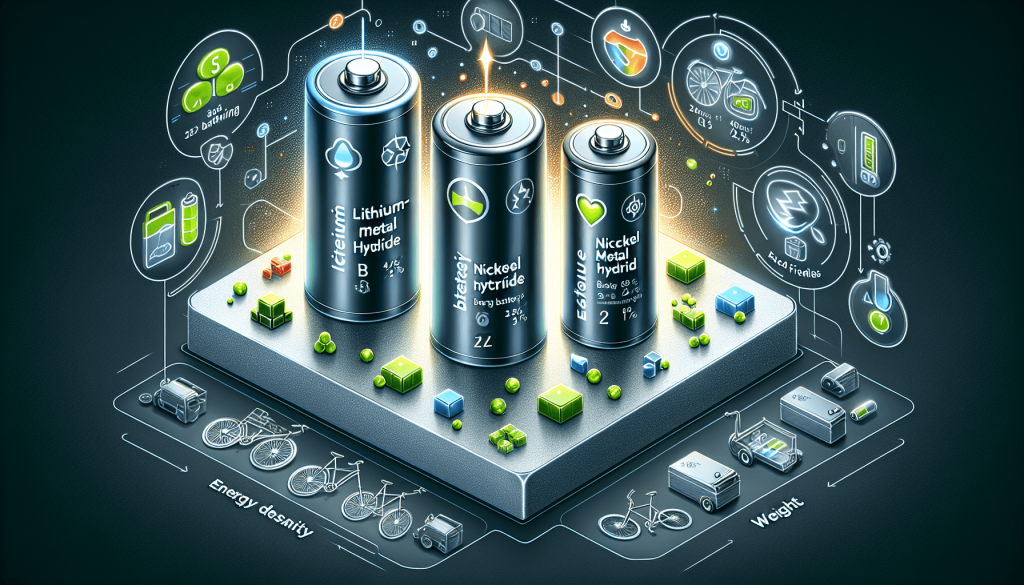
Considerations for Safety and Regulations
UN/DOT transportation regulations
When dealing with eBike batteries, it’s important to ensure compliance with transportation regulations. The United Nations (UN) and the Department of Transportation (DOT) have specific regulations regarding the transportation of lithium-ion batteries. Familiarize yourself with these regulations to ensure that you handle, transport, and store your eBike battery safely and legally.
Battery management system (BMS)
A battery management system (BMS) is an essential component of eBike batteries. It helps monitor and control various battery parameters, such as cell voltage, temperature, and state of charge. A robust BMS can help optimize battery performance, ensure safe operation, and prolong the lifespan of the battery.
Temperature management
Proper temperature management is crucial for the safe and optimal performance of eBike batteries. Extreme temperatures, both high and low, can negatively impact battery performance, capacity, and lifespan. Ensure that your eBike battery is stored, charged, and operated within the recommended temperature range to maintain its performance and longevity.
Proper storage and handling
Proper storage and handling of eBike batteries are important for safety and longevity. Follow manufacturer guidelines for storing and handling your battery, including recommendations for charging, discharging, and storing. Avoid exposing the battery to extreme temperatures, humidity, or physical damage, as this can affect its performance and safety.
Safety certifications
When purchasing an eBike battery, look for batteries that have undergone safety certifications. These certifications, such as UL (Underwriters Laboratories) or CE (Conformité Européene), indicate that the battery has met certain safety standards and has undergone rigorous testing to ensure safe operation.
Warranty and customer support
Consider the warranty and customer support offered by the battery manufacturer or retailer. A reliable warranty can provide peace of mind in case of any potential defects or issues with the battery. Additionally, good customer support can assist you with any questions or concerns regarding the battery’s operation, maintenance, or troubleshooting.
Conclusion
Choosing the best battery for your eBike is not a one-size-fits-all decision. It requires careful consideration of your specific requirements, as well as an understanding of the different types of batteries available. Evaluate factors such as energy density, lifespan, charging time, and cost to find the battery that best aligns with your needs. Consider consulting with reputable eBike manufacturers and experts who can provide valuable insights and recommendations. By understanding the trade-offs between cost, performance, and longevity, you can make an informed decision and enjoy the benefits of a reliable and efficient eBike battery.
